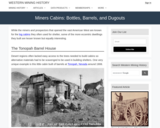The burden that a typical three- to six-week field-methods course may place on students in terms of time (absence from work and family responsibilities) and money (cost of travel, cost of course, lost wages) can negatively affect learning, or even access to the course itself. This is particularly true for students in urban, non-residential colleges. One approach to addressing this issue is to design a field course in a modular fashion; essential skills are introduced and practiced in local settings; the skills are integrated and reinforced in a culminating "out-of-town" mapping project of reduced duration. This assignment is an example of one such pre-travel activity, in which students develop skills in outcrop description, analysis, and correlation/categorization with other outcrops.
Students are assigned map areas within a historic business neighborhood (e.g., Wall Street in Lower Manhattan) such that each assigned area has some overlap with those of other groups. In pairs or small groups, students are required to examine the stone(s) that comprise the outside lower-level of each building within the map area, and do the following:
In field notebooks, fully describe the rock(s) exposed in each building.
Determine how many unique stones are exposed in the map area.
Identify which buildings are composed of the same stone (i.e., share the same mineralogical, textural, and/or paleontological characteristics, and so are likely quarried from approximately the same locality).
Write a composite description of each distinct stone, emphasizing the features that help to distinguish each "unit" from the others exposed in the map area, and including photos that illustrate the diagnostic features and representative appearance of the rock. Classify each stone, and describe the conditions under which each unit formed.
The field work is conducted over a minimum of two days. During Day 1 students work through as much of the map area as they can, making detailed outcrop descriptions and some initial correlations between units. Subsequently, students meet as a class to discuss their observations, define criteria to distinguish units, and assign all outcrops from Day 1 into distinct units. On the second field day students begin re-examine key buildings from Day 1 to confirm or refute their proposed correlations. During the remainder of the day, students complete the coverage of their map area. Groups may choose to revisit their field area on their own time.
(Note: this resource was added to OER Commons as part of a batch upload of over 2,200 records. If you notice an issue with the quality of the metadata, please let us know by using the 'report' button and we will flag it for consideration.)





